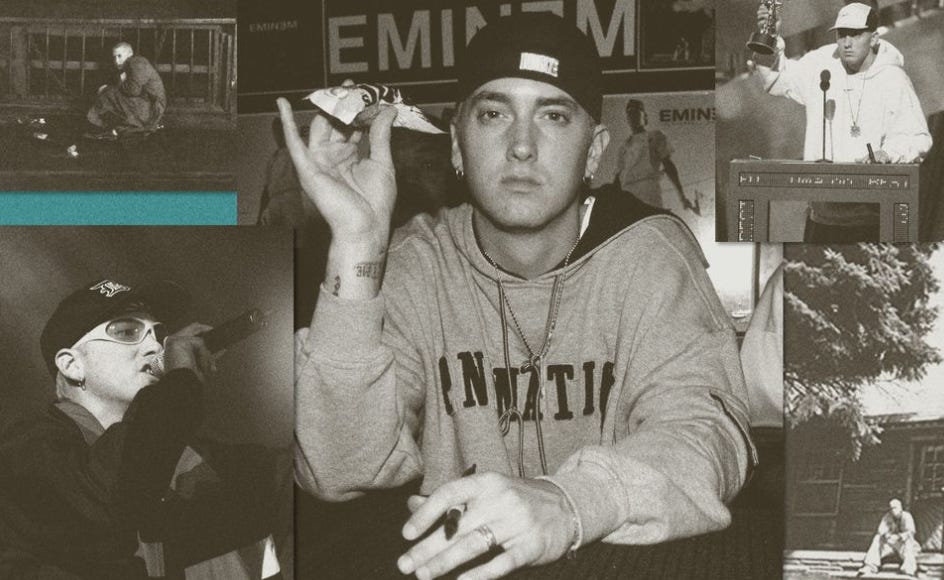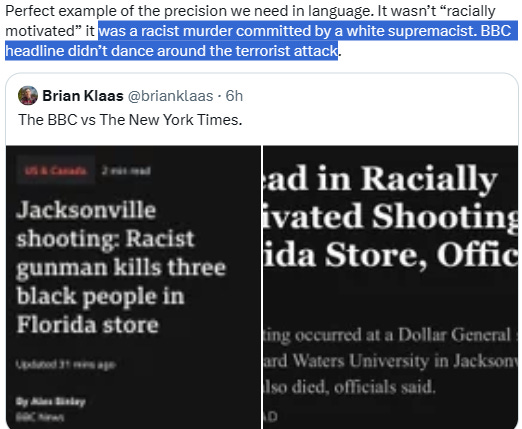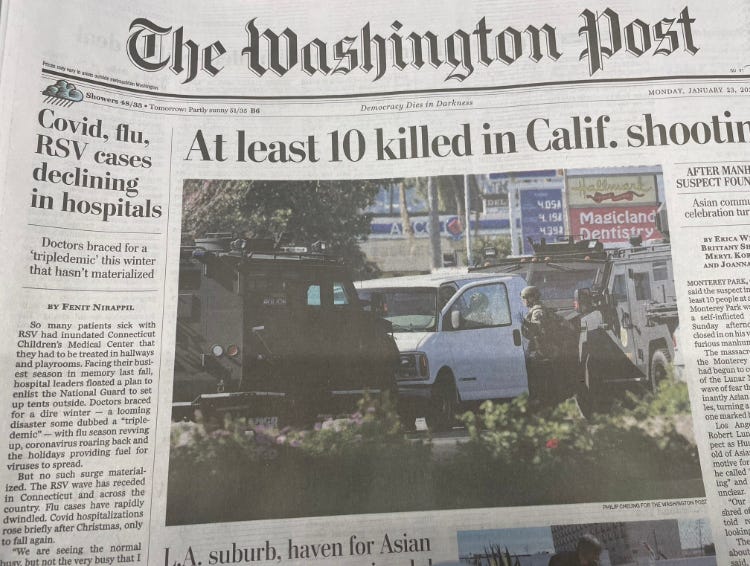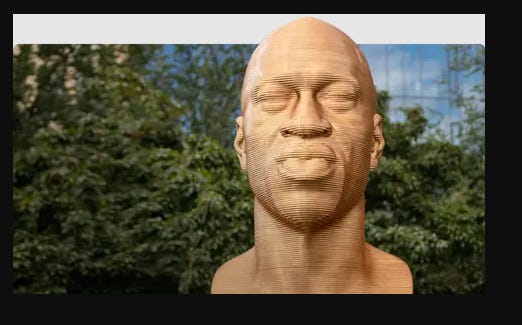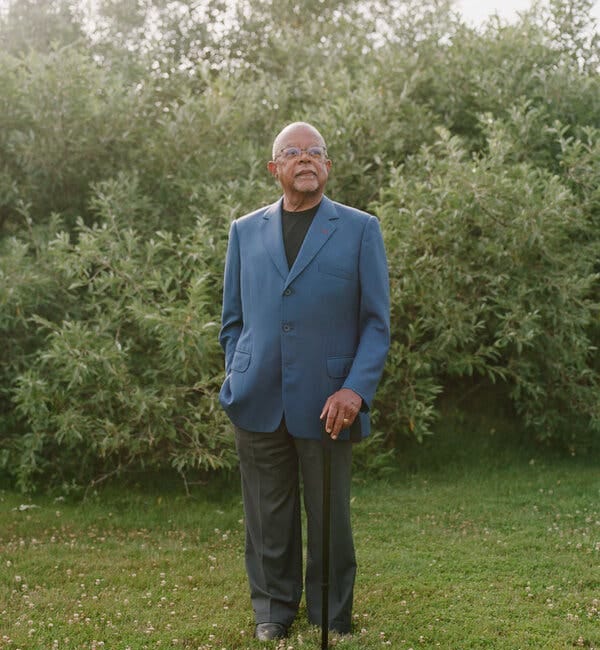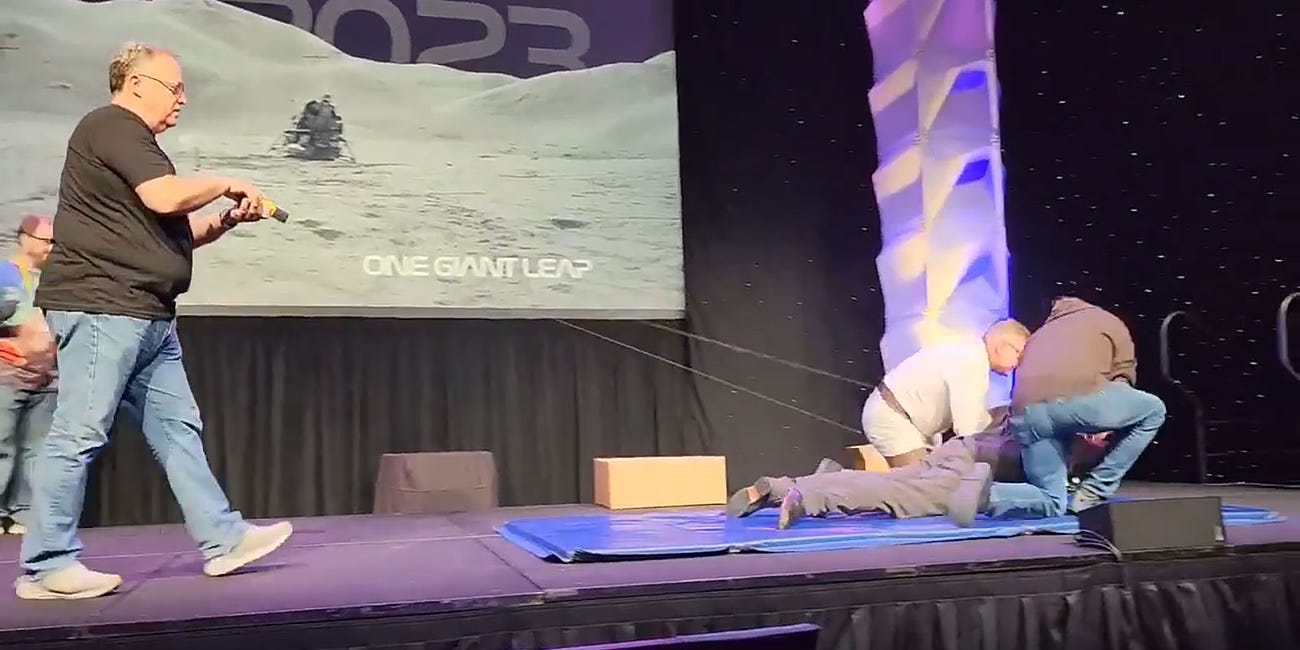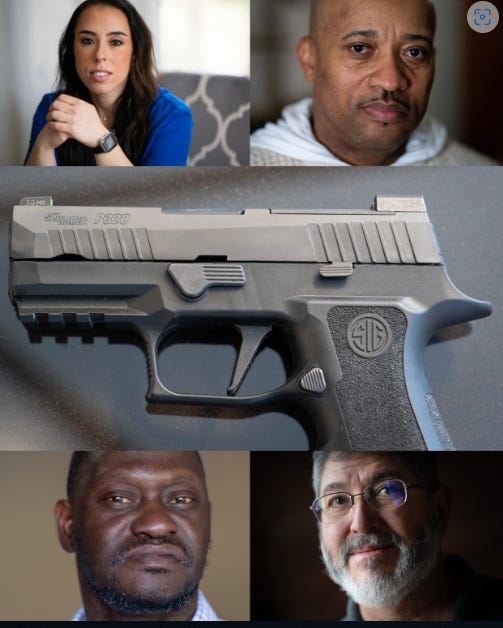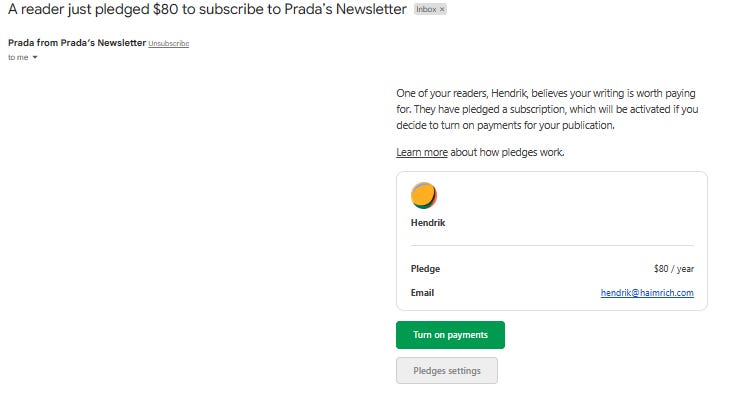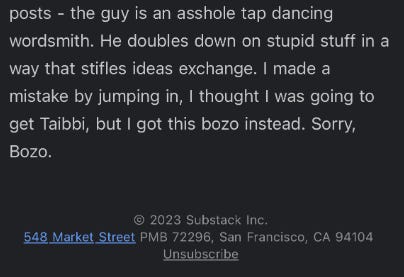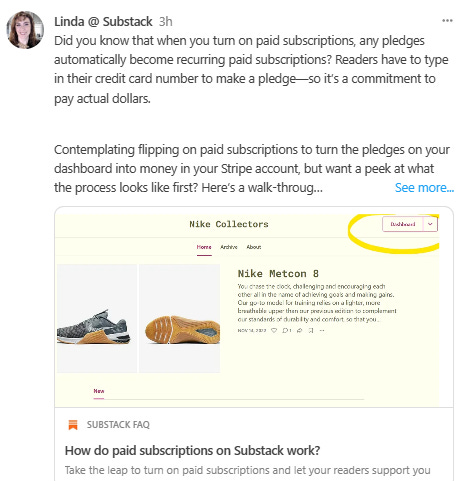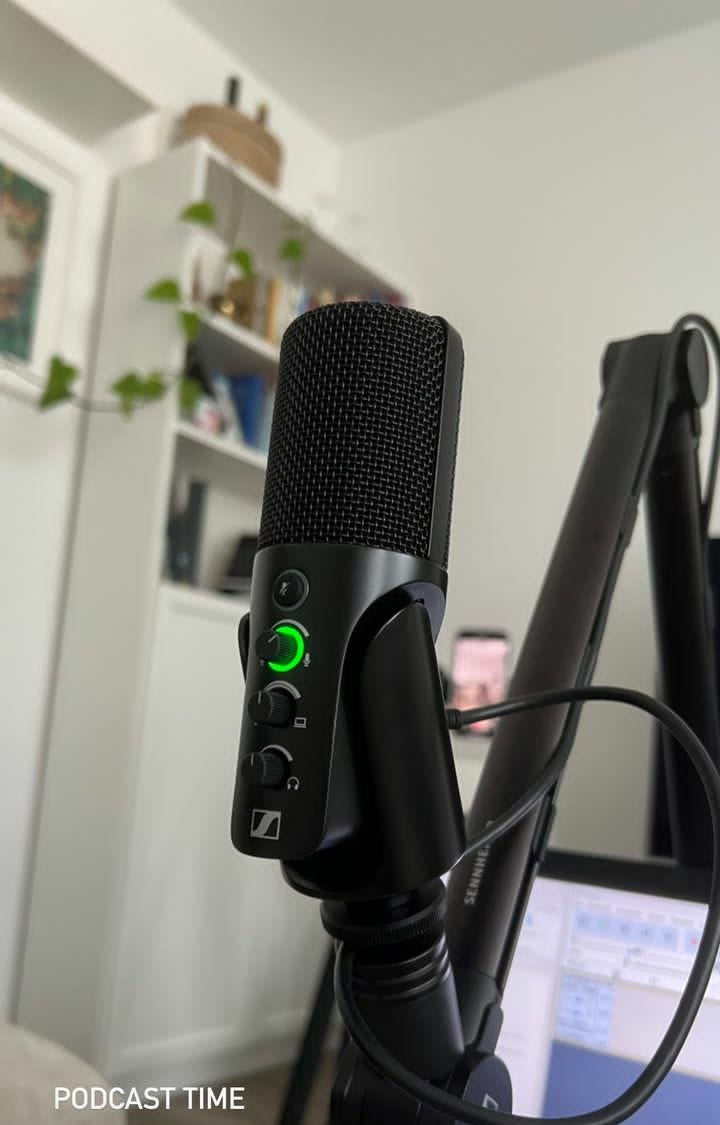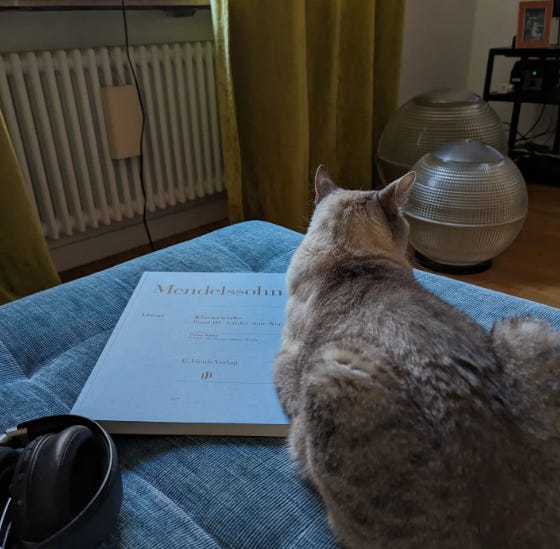DC 8.22am
The Racist who shot and killed three Black people at a Dollar General in Jacksonville on Saturday, identified in his writings a slew of other potential targets — including Eminem (Marshall Bruce Mathers III) and Machine Gun Kelly (Colson Baker).
Ryan Christopher Palmeter — who turned the gun on himself after killing Angela Michelle Carr, 52; Anolt Joseph “AJ” Laguerre Jr., 19; and Jerrald Gallion, 29 — listed both rappers by their given names alongside their stage monikers.
“Eminem (aka Marshall Bruce Mathers III, aka Slim Shady aka Ken Keniff, aka the white guy from D12): Stared the abyss (being ni–dly) and the abyss stared back (becoming a ni—er),” he wrote. “Walks the edge of ni–er lover and honorary ni–er. Fell off not because his new stuff sucked but because the lyrics were gay annoying liberal shit. ROE for Total Ni–er Death is to include Eminem (aka Marshall Mathers, aka Slim Shady aka Ken Keniff, aka the white guy from D12) as a valid target and he is to be killed on sight.”
The killer’s writings shed light on his motivations and his vile, grandiose beliefs. In his screed he hoped for a race war. And he praised fellow killers, including the Oklahoma City bomber Timothy James McVeigh, the Norwegian summer camp killer (Breivik), and the Virginia Tech school shooter for committing mass murder. He looked down on the extremist group the Boogaloo Boys as “larpers” — people only role-playing at spreading hate. OK BOMB or Oklahoma bombing introduced a frightening new concept for the United States: homegrown terrorism, a stamp which actually must labelled to every single mass shooter.
Racist mass shooters are often characterized as “lone wolves” by law enforcement. And the Jacksonville shooter acted alone in his crime. But the gunman’s writing reveals the way in which such criminals often see themselves as connected to and building off the horrific exploits of previous mass killers, even as they hope that their violence will inspire the next generation of shooters.
Palmeter continued his screed, turning his sights to Machine Gun Kelly. The gunman’s writing suggests he may have been close enough to the rapper to have taken a shot. “Colson Baker (aka Machine Gun Kelly): Honorable ni–er. To be killed on sight like Eminem because I didn’t get a shot at him up in Ohio.”
Others named in the writings include Justice Clarence Thomas (“The rare principled conservative, interprets laws based the Constitution instead of doing f—y activist shit like the last half-century’s worth of Supreme Court justices,” he wrote) and Timothy James McVeigh, the domestic terrorist who killed 168 people in the Oklahoma City bombing in 1995. Palmeter painted him in a seeming positive light, writing “He now lives in our hearts.”
Eminem was to hip-hop what Black folks have been to America. He’s from the bottom — reared on the side of 8 Mile Road where poverty was life — and was raised by a culture that doggedly oppressed his talent, dreams, and purpose. Like brave Black men pre–Civil War, his calling to battle was met with mobbish resistance. When allowed to join predominantly Black ciphers, he was marginalized. Until he began rhyming, that is. “It was always a White Men Can’t Jump situation every open mic,” says Bizarre, Em’s childhood friend and fellow member of rap group D12. “Then, after the first 10 bars, they’d start changing their minds.”
What separated Eminem from most artists who sell 10 million copies of a single album is that he mined his diamond from the underground. Although he was already a multiplatinum Grammy winner, Marshall Mathers knew that Slim Shady wasn’t platinum in the streets. In order to attain that coveted respect, the White man had to jump over giants. Like Rocky Balboa returning to his original training quarters to beat the bigger, Blacker Clubber Lang, Em tapped back into his battle rapper roots and spent the album’s buildup stacking bars under the most luminous lights.
FBI Director Christopher Wray mentioned the shooter’s writings during the briefing call on Monday with law enforcement and community leaders, Rolling Stone previously reported. The investigation to this point “reveals the perpetrator of Saturday’s attack through his own writings, through the references he made, and through his actions, make clear his intentions, his actions, his motivations, his hate,” he said.
On Saturday, Palmeter entered a Jacksonville Dollar General dressed in a tactical vest and was armed with a handgun and an AR-15 rifle, which had swastika markings on it, officials said. Authorities said prior to heading to the Dollar General, Palmeter made two stops: one was a Family Dollar store about a mile away from where the shooting took place, and after he was seen nearby on the campus of Edward Waters University, a historically Black institution.
Officials continue to piece together the events leading to the massacre. On Monday, during a call to brief national law enforcement and local leaders, details about the shooter’s motivations and investigation were disclosed.
Jacksonville Sheriff T.K. Waters provided a second-by-second timeline. The sheriff also said that in 2017, “He went for a 72 hour evaluation, but he was not committed to a mental institution.” He added on the call that he believed the shooter was able to legally purchase firearms in April and June this year because the 2017 evaluation did not result in him being committed to a mental institution and because he was 15 at the time.
According to law enforcement reports, later, while speaking with Clay County authorities, Palmeter said that he could not handle the stress any longer and that he had planned to ride his bicycle towards a Bank of America tower in downtown Jacksonville to jump off of it. The sheriff said Monday that because he hadn’t been committed to an institution and because he was a juvenile he was allowed to legally purchase firearms used in the attack.
“The shooter used multiple electronic devices with a significant amount of data,” Sherri Onks, Special Agent in charge of FBI Jacksonville office, said during the call on Monday. “So far we have identified multiple writings” that show a “hatred against African Americans and belief in the inferiority of Black people. There’s also evidence he harbored anti LGBTQ+ and anti-Semitic grievances.” She said the weapons and body armor used in Saturday’s attack “had references to previous mass shootings.” She added that the shooter hoped to inspire others to carry out similar attacks.
In 1990, the Bomb Squad represented the crème de la crème of hip-hop sonics. The almighty production team behind Public Enemy crafted “Fight the Power,” the lead single for Spike Lee’s Oscar-nominated film Do the Right Thing, and provided the pulse for Ice Cube’s classic debut album, Amerikkka’s Most Wanted. The five-man unit was Teflon — until they put together a White rap group with one of the worst names a White group could have: Young Black Teenagers. “Black, to me, is a cultural thing,” said emcee Kamron, who appears in House Party 2 unironically sporting dreadlocks. “A state of mind, a state of awareness.” The blowback was palpable; hip-hop had tolerated White rappers like 3rd Bass, but YBT’s gimmick was a bridge too far.
A decade later, the culture was fully grown. And where the Bomb Squad had slipped, Dr. Dre had soared — not just as a producer with a juggernaut label and two classics of his own, but by scoring the greatest album ever authored by a Caucasian rapper. In 2000, respect still eluded most White rappers, especially after punchlines like Vanilla Ice and Mark “Marky Mark” Wahlberg. Eminem and his second studio album, The Marshall Mathers LP, became the lyrically acclaimed, RIAA-certified diamond exception.
The album is a masterful confluence of punk, bluegrass, and subterranean hip-hop that gave life to a singular brand of Americana rap. It gave a voice to voiceless rap lovers who fancied Vicodin and lived in blue-collar cities where Black people were a rarity (think Columbine, Colorado). By the dawn of the aughts, Slim Shady had unearthed his own demographic.
“Before The Marshall Mathers LP, he was mostly shock rap and clever punchlines,” says film producer and director Erik Parker, former senior editor of The Source magazine. “His outrageous content was like a Trojan horse. With it came his artistic rise, along with a legion of White kids and ‘outsiders’ who were underserved by rap’s alpha personas.”
For music capitalists and rap fans of the Caucasian persuasion, Eminem represented the return of the Great White Hope. The rest of the culture wasn’t too happy about this configuration. After Eminem’s major-label debut, The Slim Shady LP, dropped in 1999, rap magazine XXL published a disrespectful illustration of the artist mooning the reader and an unauthorized cover story package titled “A Message to the White Man,” which included a faux Q&A based on quotes cobbled from various Eminem interviews.
And while The Source had given the Detroit spitter culture crowns like Unsigned Hype, Hip-Hop Quotable, and several covers, the mag deprived his albums of that elusive five-mic rating to denote classic material; The Marshall Mathers LP received only four. Twenty years later, Parker, who was music editor of The Source at the time of the album’s release, regrets the album’s rating. “It’s his best work by far,” he says today. “It lives up to all of the key elements that make a classic: overall impact, skill level, [and] historical significance.”
Em responded to the slights as he would in a battle: He clapped back. On the album’s title track, he hit the “cheap-ass little magazine” XXL with a couple nasty combos. “Looking back on it, [provoking Eminem in XXL] was a mistake,” says Elliott Wilson, then editor in chief at XXL and current chief content officer at Tidal. “But it did lead to a classic moment.”
Two years after The Marshall Mathers LP dropped, rapper and Source co-owner Ray Benzino compared Eminem to Vanilla Ice, claiming that if Em were Black, he’d be no more successful than the less-heralded lyrical rapper Canibus. They traded diss records, one of which called Eminem “the rap David Duke.” Eminem severed ties with the magazine and squashed beef with XXL, posing for the latter publication in early 2003 alongside Dre and their newly signed breakout star, 50 Cent. “Personally, it changed my life,” says Wilson, who outsold The Source for the first time with that pivotal cover. “It validated everything I believed could happen.”
Those who tried to paint Marshall as a culture vulture failed to understand that Eminem was neither a Vanilla Ice nor a member of Young Black Teenagers. This pale horse to behold was a unicorn.
Eminem persona was born from the late rapper Proof’s insistence that each D12 member create an alter ego. Aligning chart success with cosigns from rap purists and the greatest hip-hop producer to walk the planet allowed Eminem’s Mr. Hyde to grow hip-hop into one of the top music genres worldwide. It gave the antagonist a currency his skin promised but Detroit never paid: privilege. An American privilege that his darker peers did not possess.
Sure, Black rappers are allowed to lyrically smack and degrade Black women at their leisure. But Slim Shady owned the carte blanche to “rape sluts” and murder his ex-wife on compact disc. Imagine DMX penning a verse in which he slits a White woman’s throat and dumps her body, or Nas responding to Jay-Z’s diss track “Super Ugly” with a tale about killing his daughter’s mother.
“Em played by a different set of rules,” Parker says. “Rappers like Rakim, Jadakiss, or Jay-Z came from a space where being self-deprecating and overly playful with your words cost you the respect of your peers, social ranking in your hood, the approval of fans. Em was able to rise on a parallel track because he posed no threat to the alpha status. His authentic Whiteness allowed him to be free.”
While there aren’t many MCs who have been sued by their mothers for $10 million, raping your mom on wax remains harsh retaliation. Bizarre may claim those outlandish lyrics were justified (“His mom was certified crazy,” he says), but the apple didn’t fall far from the tree. Maybe that’s why Marshall was a moth to the flame of taboo. There are few topics more sensitive to the hip-hop community than homosexuality. For Eminem, it was a playground. In fact, The Marshall Mathers LP is his most homophobic output. Some variation of the word “faggot” appears 13 times across the album’s runtime, among other anti-gay slurs. The invitations to his penis are egregious. There’s a skit that depicts rival Detroit duo Insane Clown Posse fellating a fictional character named Ken Kaniff. Would Redman’s Doc’s Da Name 2000 go platinum with a similar interlude on its track list?
“It was a sign of the times, where the rawer you are, the iller you are,” Morales says. “A lot of stuff hasn’t aged well. Especially anything [homophobic].”
In 2001, the Journal of Criminal Justice and Pop Culture compared Em’s album to a study on misogyny in gangsta rap. Out of 490 songs released between 1987 and 1993, 22% contained lyrics articulating murder and various forms of assault toward women. The Marshall Mathers LP clocked in at 78%. It was permissible for Marshall to call Christina Aguilera a whore and Britney Spears a retarded bitch; to joke about impregnating J.Lo (Diddy’s girlfriend at the time) and send vitriolic middle fingers to teen-pop faves like NSYNC, Backstreet Boys, and Ricky Martin. (Who would say “fuck you” to Will Smith, of all people?) Whether multiplatinum, paraplegic, or deceased, no one had immunity from Eminem’s aim. Bizarre, who credits himself for inspiring Em’s shock-value style of rap, says, “When he started speaking like [actor] Christopher [Reeve] and talking about him being in a wheelchair, I thought he took it a little too far.”
The privilege The Marshall Mathers LP granted Em ran deeper than just crass shots at the famous and helpless. When his frat-boy trolling caught heat from gay activist groups (GLAAD), religious figures (James Dobson), vice presidential wives (Lynne Cheney), and the entire country of Canada, he became a sort of trailer-park Chuck D fighting the powers that be. He took aim at the very establishment that gave him his autonomy. When America’s biggest artist rubs his country’s nose in its own urine, it’s a big deal. When that artist is a natural brunette turned blond, it’s impossible to ignore.
“People forget how crazy the world was back then,” Wilson says. “We didn’t have social media, but he was really getting under people’s skin. People were really protesting him, and it was really shaking up America.”
Marshall not only took his arrows like Ali posing for Esquire, he also fired back with glee. He didn’t simply call out America, he mocked and berated it — laughed at the hypocritical accusations that his music fueled the fire within the country’s violent youth. He poked at the convenient overlooking of questionable and highly influential MTV programming or requests for censorship at the contradiction of the First Amendment. When parents wagged fingers of judgment, Em pointed back at their opioid bottles. And for all the misogyny criticism, a 2001 Teen magazine poll revealed that 74% of the girls surveyed would still date Marshall Mathers. Not even the Grammy board could resist him. “There’s no question about the repugnancy of many of his songs,” said Michael Greene, president of the National Academy of Recording Arts and Sciences, in 2000. “But it’s a remarkable recording, and the dialogue that it’s already started is a good one.”
“White people need to be made uncomfortable by White people — and Em did that,” says producer and rapper Mr. Porter, also a former D12 member and a childhood friend of Marshall’s. “He put a spotlight on White America. He made White people super uncomfortable with their truth.”
Em’s upper-class status also gave him an artistic freedom not shared with the majority of rappers wrapped in melanin: He was able to simultaneously be a chart topper and spitter of labyrinths. That is the Venn diagram center every top MC aspires to hit. Slim struck the bull’s-eye with “The Real Slim Shady,” arguably the year’s most lyrical radio rap single. Twenty years ago, very few were climbing Billboard with verses as dexterous and intricate as Eminem’s.
“The album pushed boundaries on how far you can take super-lyrical rap,” says Morales, citing “The Way I Am,” the album’s second single. “Dude’s cadence and bars and perspective is aligned flawlessly.”
“C’mon,” Porter says. “You don’t know a rapper more technical.”
In 2000, the most remarkable lyricists were rhyme technicians like Ras Kass, Big Pun, and Pharaohe Monch. Pun needed R&B singers Joe and Donnell Jones to be competitive on the airwaves. Some proclaimed that Em’s pen was a doppelgänger of Monch’s, yet the Queens rapper didn’t receive radio love until his B-boy mosh pit classic “Simon Says.” Not even a symphonic collaboration with Dr. Dre (“Ghetto Fabulous”) could give Ras Kass a hit. The truth was, historically, rappers weren’t allowed to flow like a riptide and have their lead single go quadruple platinum. There’s a reason Kendrick Lamar paid Em homage throughout his career.
“Maybe his popularity is there because of his Whiteness,” Pharoahe Monch says. “But I think Eminem keeping lyricism as a conversation every time he releases a record still benefits Royce Da 5'9", Pharoahe Monch, Black Thought, and whoever else chooses to be lyrical.”
Although The Marshall Mathers LP sold 1.7 million hard copies its first week — setting a record that would remain until Adele broke it 15 years later — the album’s true significance is that it is Eminem’s magnum opus. Jay-Z had The Blueprint. Raekwon had Only Built 4 Cuban Linx…. Mobb Deep’s catalog truly begins with The Infamous. “This was the album that legitimized him with everyone,” Morales says. “If you had an issue [with his skills], it was gone now.”
For a snapshot of the album’s seismic influence, compare the pre–Marshall Mathers LP decade of White rappers like Everlast and MC Serch with the post-2000 landscape of Action Bronson, G-Eazy, and the late Mac Miller. By conceiving his own republic of rap, with a new demo to tow, Eminem homogenized the White rapper. “Here was a rapper who was truly breaking the color barrier,” Parker says.
“We never thought a White MC could be that skillful and a superstar,” says Wilson, who served as executive producer for VH1’s television show Ego Trip’s The (White) Rapper Show in 2007. “He knocked all those doors down. Now the world doesn’t even look at Mac Miller in the context of, ‘Oh, he’s a White rapper.’”
Eminem heard the message to the White man loud and clear. He’d heard it all his life. He listened to it throughout his climb onto rap’s Mount Rushmore. Jay-Z went on record saying (slightly inaccurately) that the only MCs selling major records in 2002 were Nelly, Em, and himself. It was a big reason why, the year prior, he entrusted Marshall to accentuate his very own magnum opus. Jay, uncharacteristically, repurposed a Royce Da 5'9" song that Em produced and obliterated lyrically and added it to The Blueprint. Some say the White boy bested Hov.
=========END————
Thank you, as always, for reading. If you have anything like a spark file, or master thought list (spark file sounds so much cooler), let me know how you use it in the comments below. Thank you so much for letting me vent! If you enjoyed this article, you can give pledge to me same as 25 subscribers (click PLEDGE button) or simply share this article with a friend. It helps me more than you realise.
If you enjoyed this post, please share it.
______________
Professor Hendrik, Professor Eric, and another person, Prof David A. Andelman, former Bureau Chief NYTimes recommended my substack, also some Chief Technology of Financial Times (FT) recommended my substack, not only subscribe. I'd be happy to get more & more PLEDGE and recommendations for better crafted writing (via Bank Central Asia (with my full-name ADI MULIA PRADANA, clearing code 0140119, account number 0201558866 or via STRIPE. For me, prefer Bank Central Asia).
If a friend sent this to you, you could subscribe here 👇. All content is free, and paid subscriptions are voluntary.
——————————————————————————————————
-prada- Adi Mulia Pradana is a Helper. Former adviser (President Indonesia) Jokowi for mapping 2-times election. I used to get paid to catch all these blunders—now I do it for free. Trying to work out what's going on, what happens next. Now figure out and or prevent catastrophic of everything.
(Very rare compliment and initiative pledge, and hopefully more readers more pledges to me. Thank you. My note-live blog about Russia - Ukraine already click-read 6 millions, not counting another note especially Live Update Substack (mostly Live Update Election or massive incident)
=======
Thanks for reading Prada’s Newsletter. I was lured, inspired by someone writer, his post in LinkedIn months ago, “Currently after a routine daily writing newsletter in the last 10 years, my subscriber reaches 100,000. Maybe one of my subscribers is your boss.” After I get followed / subscribed by (literally) prominent AI and prominent Chief Product and Technology of mammoth global media (both: Sir, thank you so much), I try crafting more / better writing.
To get the ones who really appreciate your writing, and now prominent people appreciate my writing, priceless feeling. Prada ungated/no paywall every notes-but thank you for anyone open initiative pledge to me.
(Promoting to more engage in Substack) Seamless to listen to your favorite podcasts on Substack. You can buy a better headset to listen to a podcast here (GST DE352306207).
Listeners on Apple Podcasts, Spotify, Overcast, or Pocket Casts simultaneously. podcasting can transform more of a conversation. Invite listeners to weigh in on episodes directly with you and with each other through discussion threads. At Substack, the process is to build with writers. Podcasts are an amazing feature of the Substack. I wish it had a feature to read the words we have written down without us having to do the speaking. Thanks for reading Prada’s Newsletter.
Wants comfy jogging pants / jogginghose amid scorching summer or (one day) harsh winter like black jogginghose or khaki/beige jogginghose like this? click
Headset and Mic can buy in here, but not including this cat, laptop, and couch / sofa.




